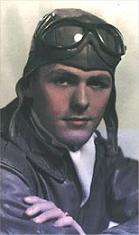Bud Wolfe
| Roland Wolfe | |
|---|---|
|
Portrait of Bud Wolfe | |
| Nickname(s) | Bud |
| Born | 12 January 1918 |
| Died | 28 January 1994 (aged 76) |
| Allegiance |
|
| Service/branch |
|
| Rank | Lieutenant Colonel |
| Battles/wars |
World War II Korean War Vietnam War |
Roland 'Bud' Wolfe January 12, 1918 - January 28, 1994, was an American pilot who parachuted from an RAF Spitfire plane into a peat bog on the Inishowen peninsula in County Donegal, Ireland, on 30 November 1941. The incident initiated a diplomatic row between Britain and Ireland.[1]
The 23-year-old, a member of No. 133 Squadron RAF, originally from Nebraska, was on convoy patrol when his engine overheated, eight miles from his RAF station at Eglinton — now the City of Derry Airport. Realising he would certainly crash, he radioed back to his station with a last message: "I'm going over the side."[2] He then pushed back the Spitfire's canopy, released his safety harnesses and jumped out of the plane.
The plane penetrated deep into the peat when it crashed. Seventy years later in 2011, historian Jonny McNee began searching for the missing Spitfire, following numerous failed attempts by others, and in June 2011 discovered the wreckage near Moneydarragh, Co Donegal. A team of archaeologists, also found the plane's eight Browning .303 machine guns and about a thousand rounds of ammunition buried 15 feet deep.[3]
Because he joined the British war effort while the US was still neutral, he was stripped of his US citizenship.[1][4] The RAF pilot was interned at the Curragh army camp in the neutral state of Ireland (Eire). On 13 December 1941, he walked out of camp, caught the train from Dublin to Belfast and was back at RAF Station Eglinton within hours.[5] He was subsequently arrested and held for two more years while the authorities in the UK and Ireland debated how to handle his escape. In 1943 he escaped again and this time was sent to the United States Army Air Force (USAAF) where he served for the rest of the war.[6]
He later served as a pilot in Korea and Vietnam, and died in Florida in 1994. He retired as a lieutenant colonel,[7] with 12,000 flying hours logged and approximately 900 combat missions to his credit in all three wars.[4]
The dig was filmed by Derry-based TV company 360 Productions for a BBC series on military archaeology, and the Spitfire plane is preserved at the Tower Museum in Derry. The machine guns recovered were found to be in relatively good condition and one was actually fired.
References
- 1 2 "BBC News - Spitfire down: The WWII camp where Allies and Germans mixed". BBC News Online. June 28, 2011. Retrieved November 10, 2011.
- ↑ Independent digital: (June 29, 2011). "Wreckage of RAF Spitfire dug up after 70 years in Donegal bog - National News". Irish Independent. Retrieved November 10, 2011.
- ↑ "BBC News - Spitfire redux: The WWII guns firing after 70 years buried in peat moss". BBC News Online. November 10, 2011. Retrieved November 10, 2011.
- 1 2 Deeney, Donna (December 11, 2011). "Exactly 70 years on... daughters of Spitfire pilot who cheated death visit crash site". Belfast Telegraph. Retrieved August 27, 2012.
- ↑ Margolis, Jonathan (April 21, 1999). "Good morning, campers". The Guardian. Retrieved August 27, 2012.
- ↑ "Secrets Of Spitfire That Crashed 70 Years Ago - The Armed Forces Community". Hmforces.co.uk. Retrieved November 10, 2011.
- ↑ "Spitfire wheel back at wartime home". Belfast Telegraph. August 11, 2011. Retrieved August 27, 2012.
External links
- Grounded In Eire, The Story of Two RAF Fliers Interned in Ireland during World War II
- Oral history interview with Barbara Wolfe Kucharczyk, 2003
- 4th Fighter Group WWII Official WWII Association Website
